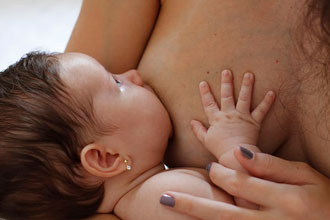Weaning

The first year is the time when the biggest dietary changes are made during a child's life.
It goes from a liquid diet, based on mother's milk or formula, to include a varied series of solid and liquid foods, which will progressively lead to an adult-type eating pattern. It is the period known as "weaning" or "weaning" and constitutes a period of great importance in the child's life.
According to Klein, weaning should begin at 6 months, and he recommended that the mother do it progressively through a peaceful and loving attitude. She also recommended interspersing breastfeeding with the bottle to achieve, step by step, object substitution.
International recommendations such as WHO, UNICEF and AEPED that advocate maintaining exclusive breastfeeding up to 6 months of life of the baby, and that weaning occurs when the mother and baby so wish, never before the age of two. This recommendation is valid for all the countries of the world, and not only in underdeveloped countries. However, due to various circumstances we must be somewhat flexible with this advice, but no complementary food should be introduced before the end of the fourth month.
Weaning strategies:
Do not offer, do not refuse: It does not guarantee how long weaning can last. It is the least painful for the child.
Distraction: It is about identifying the moments, places and circumstances in which the child usually asks for the breast and anticipating alternatives to breastfeeding, so that the child directs his attention towards something new and attractive instead of towards the loss of something endearing such as breastfeeding .
Substitution: Food or drink is offered to the child to prevent
ask for the breast for hunger. It is not about bribing with candy so that it leaves the chest. It will only work when the child is hungry. It should be borne in mind that children also suckle out of affection for their mother, to feel her closeness, for comfort if they are tired, frustrated or afraid.
Postponement: With a child who already understands us, the delay of a feeding can be negotiated. The child must be mature enough to accept the wait. You can offer him something to keep him happy in the meantime.
The feelings that the mother has about weaning are important, it is necessary that she be affectionate, attentive and encouraged with her son while she lasts the process. If she felt guilty she could be unloving towards her son, so the little one may become anxious and demand the breast more often.
Weaning by abandonment, that is, that the mother separates from the child for a few days, is not recommended, since the child is not only abruptly deprived of his mother's milk, but also of her presence, which is vital for their affective and emotional health. Weaning, like breastfeeding and any important point in raising a child, should be remembered as something that was done in a pleasant way and leaving fond memories for both of you. This change, so important to both, they should face it together, not each by her side and mourning the loss of her.
One of the benefits of a gradual and programmed weaning is that the mother can be flexible and adapt to circumstances as they arise. If a baby becomes overly angry or cries and insists on nursing despite attempts at distraction, weaning may go too fast for him. Other symptoms that can lead to postponement of weaning are exaggerated nocturnal awakenings, excessive attachment to the mother, disproportionate fear of separation, etc. All of these symptoms may or may not be due to weaning, and if the mother is concerned she can postpone weaning to see if they disappear.
If weaning is done gradually, the breast gradually returns to its initial resting situation, ceasing to produce milk. If it is abrupt, conditions such as engorgement, obstruction or mastitis may occur, so the mother should pay special attention to her breast to look for any abnormal signs, such as pain, redness or heat. These symptoms may be a sign that weaning is too fast, perhaps both mother and child need a little more time.
It does not make sense to offer bottles to children who know how to drink in learning cups or in normal cups because we are going to wean them, since we are introducing an object that they will have to give up again sooner or later, with the consequent emotional expense that it implies.
Texts: Mariela - Nanny Psychologist
Bibliography:
Esmeralda Moreno Sobrin. (). Breastfeeding from mother to mother. Chapter 22. Weaning. Epub: Digital version
Juan Carlos Vitoria Cormenzana. (2006). Weaning is a crucial period in the nutrition of the child. Journal of primary care pediatrics Vol. VIII. Epub: Digital version
Klein, M. (1932). The psychoanalysis of children. Epub: Digital version
As always, we are here to help you with your children to take care of them, give them love and make them very happy.
Share this information to achieve together a very happy life in children's childhood.
A hug, the Nanny Heart team.
- Details
- Hits: 772
© Nanny Heart 2022 - Website design MGF Creative Solutions. - Políticas de cookies y privacidad


